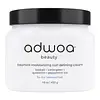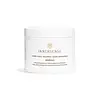What's inside
What's inside
 Key Ingredients
Key Ingredients

No key ingredients
 Benefits
Benefits

 Concerns
Concerns

 Ingredients Side-by-side
Ingredients Side-by-side

Water
Skin ConditioningBehentrimonium Methosulfate
Cetearyl Alcohol
EmollientButyrospermum Parkii Butter
Skin ConditioningBeeswax
Emulsion StabilisingPrunus Amygdalus Dulcis Oil
Skin ConditioningAdansonia Digitata Oil
EmollientHoney
HumectantGlycerin
HumectantGlyceryl Stearate
EmollientParfum
MaskingOpuntia Ficus-Indica Seed Oil
EmollientSilk Amino Acids
HumectantTocopheryl Acetate
AntioxidantDehydroacetic Acid
PreservativeBenzyl Alcohol
PerfumingGaultheria Procumbens Leaf Oil
MaskingMentha Piperita Oil
MaskingMentha Viridis Leaf Oil
AstringentLavandula Spica Herb Oil
PerfumingRosmarinus Officinalis Leaf Oil
MaskingUrtica Dioica Extract
AstringentWater, Behentrimonium Methosulfate, Cetearyl Alcohol, Butyrospermum Parkii Butter, Beeswax, Prunus Amygdalus Dulcis Oil, Adansonia Digitata Oil, Honey, Glycerin, Glyceryl Stearate, Parfum, Opuntia Ficus-Indica Seed Oil, Silk Amino Acids, Tocopheryl Acetate, Dehydroacetic Acid, Benzyl Alcohol, Gaultheria Procumbens Leaf Oil, Mentha Piperita Oil, Mentha Viridis Leaf Oil, Lavandula Spica Herb Oil, Rosmarinus Officinalis Leaf Oil, Urtica Dioica Extract
Water
Skin ConditioningBeeswax
Emulsion StabilisingButyrospermum Parkii Butter
Skin ConditioningCetearyl Alcohol
EmollientMaltodextrin/Vp Copolymer
Cetyl Alcohol
EmollientOlea Europaea Fruit Oil
MaskingGlycerin
HumectantHelianthus Annuus Seed Oil
EmollientBehentrimonium Methosulfate
Citrus Aurantium Dulcis Peel Oil
MaskingCitrus Medica Peel Oil
Eucalyptus Globulus Oil
Ginkgo Biloba Leaf Extract
Skin ConditioningCetyl Hydroxyethylcellulose
Emulsion StabilisingSodium Benzoate
MaskingPotassium Sorbate
PreservativeBenzyl Alcohol
PerfumingHydrolyzed Quinoa
Skin ConditioningPanthenol
Skin ConditioningLimonene
PerfumingWater, Beeswax, Butyrospermum Parkii Butter, Cetearyl Alcohol, Maltodextrin/Vp Copolymer, Cetyl Alcohol, Olea Europaea Fruit Oil, Glycerin, Helianthus Annuus Seed Oil, Behentrimonium Methosulfate, Citrus Aurantium Dulcis Peel Oil, Citrus Medica Peel Oil, Eucalyptus Globulus Oil, Ginkgo Biloba Leaf Extract, Cetyl Hydroxyethylcellulose, Sodium Benzoate, Potassium Sorbate, Benzyl Alcohol, Hydrolyzed Quinoa, Panthenol, Limonene
Ingredients Explained
These ingredients are found in both products.
Ingredients higher up in an ingredient list are typically present in a larger amount.
Beeswax is natural wax produced by honey bees and can be synthetically created. It consists mainly of fatty acid esters and long-chain alcohols.
In cosmetics, beeswax is a emollient. Due to its waxy structure, it creates a protective barrier. This barrier prevents water from evaporating off the skin.
This may not be a good ingredient for oily skin. We recommend speaking with a professional if you have concerns.
Beeswax cannot be removed with water, but can be taken off with an oil cleanser.
Beeswax is also antiseptic and contains vitamin A.
Learn more about BeeswaxBehentrimonium Methosulfate is an ammonium salt. It is mainly used to prevent static in haircare products as a surfactant.
Surfactants have differing ends: one side is hydrophilic while the other end is hydrophobic.
Surfactants also help your cleansers remove pollutants more easily from the skin.
Learn more about Behentrimonium MethosulfateBenzyl Alcohol is most commonly used as a preservative. It also has a subtle, sweet smell. Small amounts of Benzyl Alcohol is not irritating and safe to use in skincare products. Most Benzyl Alcohol is derived from fruits such as apricots.
Benzyl Alcohol has both antibacterial and antioxidant properties. These properties help lengthen the shelf life of products. Benzyl Alcohol is a solvent and helps dissolve other ingredients. It can also improve the texture and spreadability.
Alcohol comes in many different forms. Different types of alcohol will have different effects on skin. This ingredient is an astringent alcohol.
Using high concentrations of these alcohols are drying on the skin. They may strip away your skin's natural oils and even damage your skin barrier. Astringent alcohols may also irritate skin.
Other types of astringent alcohols include:
According to the National Rosacea Society based in the US, you should be mindful of products with these alcohols in the top half of ingredients.
Any type of sanitizing product will have high amounts of alcohol to help kill bacteria and viruses.
Learn more about Benzyl AlcoholThis ingredient is also known as shea butter. It is an effective skin hydrator and emollient.
Emollients help soothe and soften your skin. It does this by creating a protective film on your skin. This barrier helps trap moisture and keeps your skin hydrated. Emollients may be effective at treating dry or itchy skin.
Shea butter is rich in antioxidants. Antioxidants help fight free-radicals, or molecules that may harm the body. It is also full of fatty acids including stearic acid and linoleic acid. These acids help replenish the skin and keep skin moisturized.
While Shea Butter has an SPF rating of about 3-4, it is not a sunscreen replacement.
Shea butter may not be fungal acne safe. We recommend speaking with a professional if you have any concerns.
Learn more about Butyrospermum Parkii ButterCetearyl alcohol is a mixture of two fatty alcohols: cetyl alcohol and stearyl alcohol. It is mainly used as an emulsifier. Emulsifiers help prevent the separation of oils and products. Due to its composition, it can also be used to thicken a product or help create foam.
Cetearyl alcohol is an emollient. Emollients help soothe and hydrate the skin by trapping moisture.
Studies show Cetearyl alcohol is non-toxic and non-irritating. The FDA allows products labeled "alcohol-free" to have fatty alcohols.
This ingredient is usually derived from plant oils such as palm, vegetable, or coconut oils. There is debate on whether this ingredient will cause acne.
Due to the fatty acid base, this ingredient may not be Malassezia folliculitis safe.
Learn more about Cetearyl AlcoholGlycerin is already naturally found in your skin. It helps moisturize and protect your skin.
A study from 2016 found glycerin to be more effective as a humectant than AHAs and hyaluronic acid.
As a humectant, it helps the skin stay hydrated by pulling moisture to your skin. The low molecular weight of glycerin allows it to pull moisture into the deeper layers of your skin.
Hydrated skin improves your skin barrier; Your skin barrier helps protect against irritants and bacteria.
Glycerin has also been found to have antimicrobial and antiviral properties. Due to these properties, glycerin is often used in wound and burn treatments.
In cosmetics, glycerin is usually derived from plants such as soybean or palm. However, it can also be sourced from animals, such as tallow or animal fat.
This ingredient is organic, colorless, odorless, and non-toxic.
Glycerin is the name for this ingredient in American English. British English uses Glycerol/Glycerine.
Learn more about GlycerinWater. It's the most common cosmetic ingredient of all. You'll usually see it at the top of ingredient lists, meaning that it makes up the largest part of the product.
So why is it so popular? Water most often acts as a solvent - this means that it helps dissolve other ingredients into the formulation.
You'll also recognize water as that liquid we all need to stay alive. If you see this, drink a glass of water. Stay hydrated!
Learn more about Water